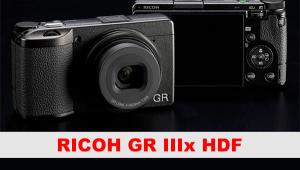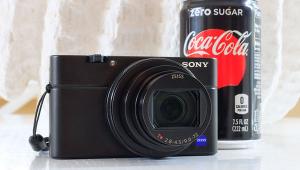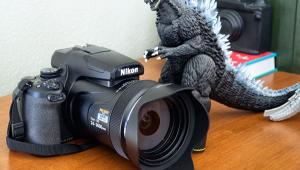Sony Cyber-shot RX100 V Compact Camera Review

(Editor’s Note: Lab Review lab tests and comments are supplied by BetterNet, Shutterbug’s TIPA-affiliated testing lab and edited by George Schaub. TIPA is a worldwide association of photo and imaging magazines. You can see full resolution sample images we shot with the Sony RX100 V here.)
The Sony Cyber-shot RX100 V is a very compact and stylish camera with loads of power “under the hood.” It features a 13.2x8.8mm (aka 1-inch type) sensor with an image resolution of 20 megapixels. The camera’s high-speed lens system (f/1.8-f/2.8) has a zoom factor of nearly 3x (24-70mm, 35mm film equivalent). The sensor system and lens have not changed from the forerunner RX100 IV, but the new RX100 V has a remarkably faster and new AF system with 315 AF areas that cover 65 percent of the image. Focusing is precise even when the photographer wants to focus on elements located in the corners of the image. (You can view full-resolution action shots we captured with the RX100 V at this URL: http://bit.ly/2gIPj11.)




Features, Build & Handling
The AF system is based on a phase-detection system (similar to that used in SLRs and hybrid focusing systems) that makes it extremely fast. Sony specifies a mere 0.05 seconds as the internal AF speed, which seems to be a realistic claim. The camera is able to record up to 25 frames per second (fps) in full resolution. It has very large image buffers: in our tests we were able to shoot up to 190 frames at 25 fps. In Raw mode the camera is able to shoot 150 frames before it pauses.
During our tests, the RX100 V showed an excellent performance when focusing on fast-moving subjects. The camera offers different focus modes, including “Flexible Spot” metering or “Expanded Flexible Spot,” which is an alternative version of “Flexible Spot” that uses additional AF areas when the Sony fails to focus on the single selected point.
Just like the RX100 IV, the camera features an electronic viewfinder system. The EVF is a pop-up system that is activated by moving a small slider on the left-hand side of the body. In addition, the photographer has to pull out the ocular of the viewfinder, so two hand movements are needed to start using the viewfinder. When pushing the viewfinder back into the camera it automatically shuts down. The viewfinder has a very high resolution of 2.36 million RGB dots and is based on an OLED system that creates a brilliant and crisp image. The camera also has a swivel LCD on the back that can be used as a viewfinder. The mechanism allows the user to flip the screen into a 180-degree position for selfie shots. It can’t be rotated to the side of the camera.
The camera offers a four-way control field on the back for menu navigation. Pressing the four direction buttons allows the user to set up parameters like display or drive mode directly. The control field also has a dial that is used to set up image parameters. In combination with the lens ring, the camera has fast and easy handling and intuitive setup of all parameters. Compared to a large SLR or CSC system, the small body and the functional elements of the RX100 V aren’t really ergonomic. This is countered by the portability of the camera and the ability to work in candid fashion along with professional-quality image results.
The Sony RX100 V has a large mode dial on the top. It allows for selection of standard exposure modes (P, S, A, and M), scene modes, and special modes like “HFR,” which allows the user to take slow-motion video with up to 1,000 fps.
By using free apps for Android and Apple iOS, the camera can use a smartphone and other mobile devices as a remote control. NFC establishes an easy connection between a smartphone and the camera.

Comments on Image Quality
Color: The Sony RX100 V showed nice and natural-looking colors in our tests. The automatic white balance system worked well with all kinds of lighting systems: the GretagMacbeth chart was reproduced with close-to-perfect white balance. Nearly all gray circles in our result chart are located in the center of the image or with only a minor shift into the blue area of the color space. Only the bright white circle shows a shift into the opposite direction. The shift of light gray nuances is also noticeable in our portrait shot. Saturation is a little exaggerated (107.4 percent), but still looks very good. Darker blue nuances are stressed and highly saturated. The camera reproduced skin tones very nicely with a little boost of magenta and yellow rates.

Sharpness: The resolution results of the Sony RX100 V are excellent. The camera reproduced the ISO 12.233 test chart with 3,529 of 3,648 lines per picture height, the nominal sensor resolution. But Imatest results show a “clipping warning” due to contrast lines being emphasized by an intense sharpness filtering. In real-life images the sharpness filtering is considerably less remarkable. The excellent differentiation of colors enhances the high sharpness of the images, which is a result of a high-end sensor and an integral lens system.
Noise: Due to its small sensor (at least when compared to APS-C and full-frame sensors) the Sony RX100 V showed a higher luminance noise level in ISO 80 mode (0.7 percent). When using higher ISO speed settings like ISO 100 and ISO 200 the luminance noise factor decreases because the camera starts to use a more intense anti-noise filtering. With higher ISOs the luminance noise increases again but stays on an acceptable level even at ISO 6400 and ISO 12,800.
Color noise gets visible in images taken with ISO 1600 but is still very discreet (smoothed by filtering). The camera uses a very intelligent noise filtering that can create a slight blur effect, but these effects stay on a very low level up to ISO 6400. At ISO 12,800, images will show the well-known combination of noise artifacts and anti-noise filtering.
The camera showed excellent results in our dynamic tests. At ISO 200 it achieved a maximum of 11.5 f/stops and kept a high level of more than 10 f/stops in the ISO 80 to ISO 800 range. Only when taking photos with higher ISO speeds does the dynamic range drop to less then 8 f/stops.

Comments on Video Functions
The Sony RX100 V offers 4K video recording (3840x2160 pixels) and Full HD movies (1920x1080 pixels). Recording time for 4K video is restricted to five minutes. It is able to record standard AVCHD 2.0 files (Full HD, 28 Mbit/s) and offers Sony’s XAVC-S file format for high-resolution videos with up to 25/30 fps (PAL/NTSC compatible) and up to 100 Mbit/s. Using Full HD resolution allows recording with up to 50/60 fps (PAL/NTSC compatible). Recording videos in high-resolution modes and with high band rates requires use of a high-speed storage system such as a UHS-I-compatible SDXC card.
The camera offers P, S, A, and M modes when recording video: they are accessible in the menu when the mode dial is switched into the MOVIE icon position. It also allows the user to manually set up focus and ISO speed settings.
Besides its normal video modes, the camera offers an “HFR” mode for slow-motion videos. These “High Frame Rate” modes offer 250, 500, and 1,000 fps. Compared to the forerunner RX100 IV, it now allows the user to shoot longer: eight instead of four seconds. All high-speed movies are scaled to Full HD (1920x1080), but recorded with less image resolution (250 fps: 1824x1026 pixels; 500 fps: 1676x566 pixels; 1,000 fps: 1136x384 pixels). We suggest that using the 250 fps mode affords a very reasonable compromise between slow-motion effects and image quality.

Comments on Video Quality
The new Sony RX100 V showed good results in our video resolution and color tests. Full HD videos are reproduced with 740 of 1,080 lines per picture height (which is a more than average result), while the 4K images show 1,888 of 2,160 lines per picture height, which is a very good result.
Color reproduction in videos is similar to colors in photos. Our tests show that neutral gray colors are located in the center of the result graphic (which means no color shift); brighter white tones show a shift into the yellow and greenish area. All other colors are reproduced with only minor errors. The darker blue pattern in the chart is boosted and reproduced with higher saturation than other colors.
Noise results are excellent. Because of the lower resolution of the images (combined usage of pixels on the sensor for a final image pixel in the video), the luminance noise results are better than in photo mode. Even at ISO 12,800 the luminance noise level is very low (way below 1 percent). Dynamic range is lower than in photo mode. The camera achieved a maximum of 9.59 f/stops at ISO 125.
Scorecard
Pros
• Stylish, high-end compact system
• High-resolution EVF, swivel LCD
• Very good image quality
• Very fast
Cons
• Setting up the EVF requires two hand movements
• Quite expensive
• Missing accessory shoe for external flash systems
• No interface for an external microphone for video recordings
The Sony Cyber-shot RX100 V has a list price of $999. For more information, visit sony.com.
(Lab Review is where we publish web-exclusive lab reports on cameras. To read more Lab Reviews, click on the Reviews tab on the top navigation bar of this page. New photo gear reports are published frequently, so check Reviews for more equipment evaluations from Shutterbug writers.)
- Log in or register to post comments

















































